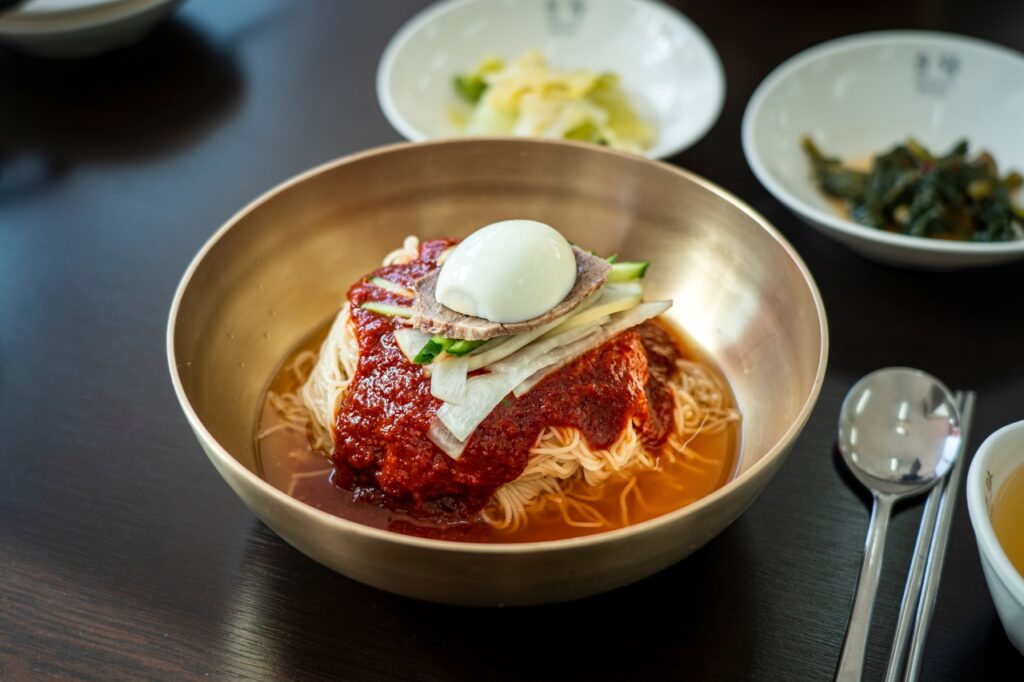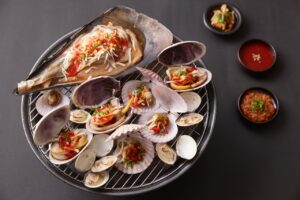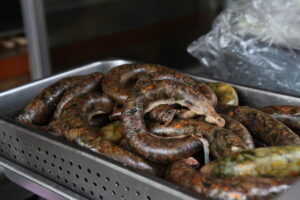
Naengmyeon-Mul ⓒ한국관광공사 사진갤러리-살롱드베이커
Naengmyeon, Indulge in the Refreshing Flavor of Korean Cold Noodles
When the sun blazes high and temperatures soar, there’s nothing quite like the cool embrace of naengmyeon, Korea’s beloved chilled noodle dish. With its origins dating back centuries, it has evolved into a tantalizing culinary masterpiece that captures the essence of Korean cuisine.
A Tradition of Cool Comfort : It’s story unfolds against the backdrop of Korean history. Its roots can be traced to the Joseon Dynasty, where creativity met necessity to create a satisfying summer delight. The dish’s transformation continued through the Japanese colonial period and the post-war era, resulting in the flavorful variations we savor today.
From Pyongyang to Hamheung:As diverse as the regions from which they hail, Pyongyang naengmyeon and Hamheung naengmyeon bring unique twists to the table. Pyongyang naengmyeon offers a mild, slightly sweet broth, while Hamheung naengmyeon tantalizes the palate with its tangy flavors derived from water kimchi.
The Art of Assembly:Whether you opt for mul naengmyeon’s delicate interplay of cold noodles and clear broth or indulge in bibim naengmyeon’s fiery dance of flavors, each bite is a symphony of taste and texture. Fresh vegetables, pickled radish, and the iconic hard-boiled egg enhance the visual appeal and culinary experience.
A Cultural Tradition: it isn’t just a dish; it’s a celebration of Korea’s cultural adaptability and culinary finesse. It’s a testament to the harmony between historical influences and local creativity, capturing the essence of each season and reflecting the ingenuity of a nation.
So, venture into the world —where tradition meets innovation, and coolness meets culinary delight. As you twirl those chilled noodles and savor the refreshing flavors, you’ll understand why it is not just a dish; it’s an experience—an edible oasis in the scorching heat of summer.
History of Naengmyeon
The history of it, or cold noodles, in Korean cuisine dates back several centuries and has evolved over time to become a beloved and iconic dish. The origins of it can be traced to the Korean peninsula’s historical interactions with China and its own culinary traditions. Here’s an overview of the history of naengmyeon:
1. Influences from China:
The concept of cold noodles is believed to have been introduced to Korea through cultural exchanges with China. Cold noodle dishes were already present in Chinese cuisine, and this culinary influence gradually made its way to Korea. The idea of serving chilled noodles was well-suited to Korea’s hot and humid summers, contributing to the popularity of the dish.
2. Development and Evolution:
IT began to take shape as a Korean dish during the Joseon Dynasty (1392-1897). At the time, noodles were made from ingredients like buckwheat and sweet potato starch. The Joseon court culture likely played a role in refining and popularizing naengmyeon.
3. Regional Variations:
Different regions of Korea developed their own variations of it, each with distinct characteristics:
- Pyongyang Naengmyeon: Originating from the capital city of North Korea, Pyongyang naengmyeon is known for its mild broth and slightly sweet flavor.
- Hamheung Naengmyeon: This variation comes from the city of Hamheung in North Korea and features a tangy and refreshing broth made with dongchimi, a type of water kimchi.
4. Japanese Colonial Period:
During the Japanese colonial rule over Korea (1910-1945), naengmyeon underwent some changes due to cultural influences. Buckwheat noodles from Japan were introduced to Korea, leading to the use of buckwheat noodles in naengmyeon dishes.
5. Post-Korean War Period:
After the Korean War, Korea experienced a period of economic recovery and rebuilding. It became a popular and affordable dish, providing a cooling and satisfying option during hot summers.
6. Modern Era:
It continued to evolve in the post-war period with variations like mul naengmyeon (served in cold broth) and bibim naengmyeon (mixed with spicy sauce). Restaurants specializing in it became more prevalent, and the dish gained a place in popular culture as a quintessential summer food.
Today, it remains a cherished dish in Korean cuisine, enjoyed by locals and visitors alike. It reflects the culinary creativity and adaptability of Korean culture over the centuries, while also serving as a refreshing and comforting option during hot weather.

How to enjoy Naengmyeon?
Eating naengmyeon is a delightful experience that involves savoring the refreshing and flavorful combination of cold noodles, broth (in mul naengmyeon), and various toppings. Here’s a step-by-step guide on how to enjoy them:
1. Get Comfortable: Find a comfortable seat and get ready to enjoy yours. Since it is a cold dish, it’s particularly popular during hot weather to help cool you down.
2. Mix the Sauce (for Bibim Naengmyeon): If you’re enjoying bibim naengmyeon (the spicy sauce version), start by thoroughly mixing the sauce. This ensures that the gochujang (red chili paste) and other seasonings are evenly distributed throughout the noodles.
3. Slurp and Savor: Using chopsticks and a long spoon, begin to take bites of the chilled noodles. Slurping the noodles is a common practice in Korean cuisine, as it’s believed to enhance the overall flavor experience. The chewy texture of the noodles combined with the cold temperature provides a unique sensation.
4. Enjoy the Broth (for Mul Naengmyeon): If you’re enjoying mul naengmyeon (the cold broth version), start by taking sips of the clear and refreshing broth. The mild and slightly seasoned broth complements the noodles and toppings.
5. Explore the Toppings: It is typically garnished with various toppings that add both flavor and texture to the dish. Explore the different toppings, such as thinly sliced cucumbers, radish, Korean pear, and sometimes a hard-boiled egg. These toppings provide a balance of freshness and crunch.
6. Mix and Match: Feel free to mix and match the toppings with the noodles and broth/sauce as you go along. Each bite can be customized to your taste preferences, creating a dynamic and enjoyable eating experience.
7. Enjoy the Refreshment: As you continue to enjoy your naengmyeon, you’ll experience the cooling and refreshing qualities of the dish. The combination of cold ingredients, flavors, and textures makes naengmyeon a unique and satisfying culinary experience.
8. Savor Until the Last Bite: Continue enjoying yours at your own pace until you’ve savored every last bite. Don’t hesitate to slurp the noodles, savor the broth, and appreciate the interplay of flavors.
9. Finish with Satisfaction: Once you’ve finished yours, you can lean back with satisfaction, relishing the unique flavors and the sense of refreshment that the dish offers.
Remember, it is not just a meal; it’s an experience. Whether you’re enjoying it with friends, family, or on your own, take your time and savor the cool and flavorful journey that this iconic Korean dish provides.
Good things to enjoy with Naengmyeon.
This is a versatile dish that can be enjoyed on its own or paired with a variety of side dishes and accompaniments. Here are some good things to enjoy with naengmyeon to enhance your culinary experience:
1. Kimchi: Kimchi is a staple in Korean cuisine and pairs wonderfully with naengmyeon. The spicy, tangy, and fermented flavors of kimchi complement the cool and refreshing nature of the dish.
2. Pickled Radish: Sweet and tangy pickled radish is a common side dish that provides a refreshing contrast to the cold noodles. Its crunchiness adds texture to your meal.
3. Korean Pancakes (Jeon): Savory Korean pancakes, known as “jeon,” come in various flavors like kimchi, seafood, or vegetable. Their diverse flavors and textures make them a great accompaniment to naengmyeon.
4. Mandu (Dumplings): Mandu, Korean dumplings, are another excellent choice to enjoy with that. They can be steamed or pan-fried and provide a satisfying contrast to the noodles.
5. Bindaetteok: Bindaetteok, or mung bean pancakes, are crispy and savory pancakes made from ground mung beans and vegetables. They’re a delightful side dish that pairs well with naengmyeon.
6. Japchae: Japchae, a Korean stir-fried noodle dish, offers a different noodle texture compared to naengmyeon. The mix of vegetables and flavors in japchae can complement the naengmyeon’s simplicity.
7. Tangy Dipping Sauces: Tangy dipping sauces, such as soy sauce with vinegar and sesame oil, can be used to enhance the flavors of the noodles and toppings.
8. Hard-Boiled Egg: Adding a sliced hard-boiled egg to yours not only offers a protein boost but also adds creaminess and flavor.
9. Fresh Fruit: Slices of fresh Korean pear or watermelon can provide a juicy and sweet contrast to the cold noodles.
10. Cold Beverage: Pair your naengmyeon with a cold drink like water, iced tea, or a traditional Korean fruit punch called “sikhye” for a well-rounded meal.
11. Side Vegetables: Served alongside naengmyeon, blanched or seasoned vegetables like spinach, bean sprouts, and seaweed can provide additional flavors and textures.
12. Fish Cake: Korean fish cakes, or “eomuk,” are often served as a side dish and can add a slightly savory and chewy element to your experience.
Ultimately, the choice of accompaniments depends on your personal preferences and the flavors you enjoy. Experiment with different combinations to discover your favorite pairings that enhance the overall enjoyment of your meal.
Recommend to Read >> Doenjang, Korean soul sauce Aug, 2023.





